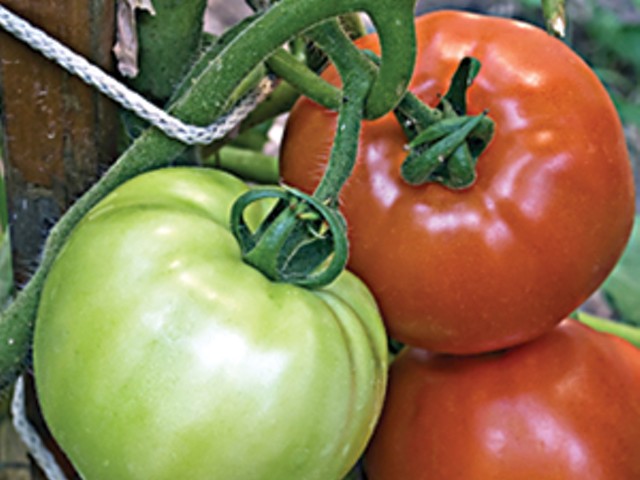After a successful six-year run in Ann Arbor, the Inhmathong family moved Banh Na, their Laotian-Thai restaurant, to 14 Mile and Campbell and changed its name to Sabidee, which means "hello" in Laotian. Like many restaurant owners, problems with a new lease caused the family to change locations from the cosmopolitan university town to white-bread Madison Heights, which does, however, boast a significant Asian presence.
Open since early July, Sabidee, a simple but attractive storefront in the Value Center Shopping Center, seats about 50 in its bright, freshly painted dining space minimally decorated with Laotian art and artifacts.
Although there are 200,000 Laotians in the United States who have emigrated from the small landlocked nation that was once part of French Indochina, their cuisine is still relatively obscure in our area. Its obscurity may relate to the fact that many Laotian refugees like Wan and Phet Inhmathong came from the northwest region of Laos, which has been culturally and politically influenced by its more powerful Thai neighbor. Indeed, most of the dishes on Wan's extensive menu are of Thai origin and will seem familiar (pad thai, tod mun, green-apple salad) to Detroiters.
But there are a handful of Laotian specialties on their extensive menu that servers Michele, Wendy and Jurney, the Inhmathong children, will identify for you. Be forewarned, Sabidee's handling of spices drifts enough toward the incendiary to require the tender-palated to request a very mild spice level instead of "mild," the tamest category on the menu. Had Wan, who fled with Phet from Laos in 1975 after the Pathet Lao took over, come from the area adjacent to Vietnam instead of Thailand, her repertoire would have been different.
For starters, her appetizer plate ($9.95), which four can share, offers spring rolls, chicken satay, fried tofu, fried plantains, curry puffs and beef jerky along with several dipping sauces. Most interesting were the creamy sweet plantains and the sprightly jerky that appeared as pieces of rather chewy bacon. A large bowl of tom kha, a silky smooth soup of coconut milk, lime, chilies and chicken ($5) is an even better way for a party of four to launch an excursion into culinary parts unknown.
Another intriguing choice is larb ($7.95), one of the most famous of Laotian standards, a tangy salad composed of chicken, meat or tofu tidbits with mint and onions in a limey, slightly saline fish sauce. Vegetarians will be pleased to find tofu as an optional ingredient in virtually every one of Sabidee's dishes.
Larb comes with sticky rice, another Laotian staple, which can be molded into little balls to sop up whatever liquid remains on your plate. Since most of the dishes automatically come with jasmine rice, you should ask for at least one order of the amusingly clumpy stuff.
Som tum, an assertively spiced salad composed of crunchy shredded papaya, tomatoes, chilies, lime, and sweet and salty crab bits or peanuts and shrimp depending upon whether you want it Laotian- or Thai-style, is a worthy alternate to larb.
Among the specifically Laotian fare recommended by Michele is Sabidee noodles ($8.50), a satisfying mélange of thin noodles with bean sprouts, green onions and meat, chicken, seafood or tofu in a surprisingly delicate, yet vigorous peanut-accented sauce. Alas, the morsels of chicken we ordered to accompany the noodles on one occasion were few and far between.
The Inhmathongs are also proud of the homemade grilled pork sausage ($7.95), which is among the fierier of their signature dishes. Similarly, although kaeng auk, a savory curried stew with eggplant, green onions, dill and green beans, bursts with flavor, the legions of diners who inexplicably do not care for cilantro may want to take a pass on this one.
A safer choice is one half of crispy duck ($14.95), a dark mahogany beauty baked and fried to near perfection — crispy as advertised on the outside, moist on the inside — and enhanced by the gentle tamarind marinating sauce. A slightly more lively tamarind and basil sauce is the base for a succulent fried-scallop preparation ($10.95). This is the sort of sauce just made for those aforementioned self-constructed sticky-rice balls.
According to Michele, basil steak ($8.95) is one of the more original of her mother's stir-fried entrées. The wonderfully sweet thick peanut sauce was more impressive than the slightly tough pieces of beef. Sweet and sour, brown with garlic, chili with shrimp, and ginger-garlic are among the sauces that bathe a variety of other stir-fries.
In addition, Sabidee features four fried-rice platters, including one presented Laotian-style with eggs and vegetables in garlic sauce, as well as pho, drunken noodles, whole tilapia, grilled Cornish hen and roasted duck curry.
Currently, dessert is limited to banana delight, three large fried plantain rolls with honey and vanilla ice cream.
Ann Arbor's loss is Madison Heights' gain. If you are looking for something different, Sabidee is an ideal introduction to the arcane Laotian kitchen and another example of Detroit's range as one of the nation's premier centers for ethnically diverse cooking. Hello, Sabidee!
Mel Small teaches history at Wayne State University. Send comments to [email protected].





